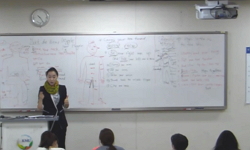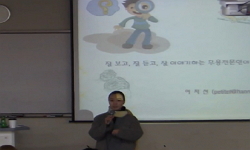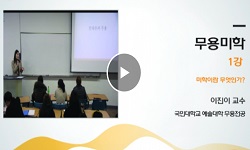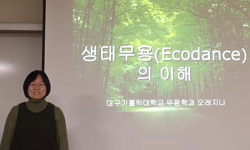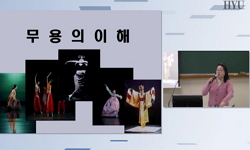이 연구는 무용전공자로서 진로결정을 하는데 있어서 영향을 준 요인들에 대한 의미를 해석함으로써 무용전공자로서의 삶을 이해하는 데 그 목적을 둔다. 이 연구에 참여한 무용전공자들은...
http://chineseinput.net/에서 pinyin(병음)방식으로 중국어를 변환할 수 있습니다.
변환된 중국어를 복사하여 사용하시면 됩니다.
- 中文 을 입력하시려면 zhongwen을 입력하시고 space를누르시면됩니다.
- 北京 을 입력하시려면 beijing을 입력하시고 space를 누르시면 됩니다.
부가정보
국문 초록 (Abstract)
이 연구는 무용전공자로서 진로결정을 하는데 있어서 영향을 준 요인들에 대한 의미를 해석함으로써 무용전공자로서의 삶을 이해하는 데 그 목적을 둔다. 이 연구에 참여한 무용전공자들은 초등학교 시절에 무용을 처음 접했으며, 예술 고등학교를 거쳐 대학에 진학했다. 연구 참여자들은 현재 무용전공자로서의 전문 교육과 경험을 바탕으로 진로를 결정해야 하는 삶의 과정 속에 놓여 있는 상태이다. 연구 참여자들은 현재라는 시간적 관점에 무용전공자로서의 삶은 무엇인가? 진로결정을 해야 하는 상황적 관점에 무용전공자로서의 생활을 어떠한가? 진로결정과 관련하여 탐구경계에 나타난 무용전공자로서의 내러티브 사고는 무엇인가? 라는 세 가지 질문의 맥락 속에서 심층 면담, 이미지 텔링, 자서전적 글쓰기 등을 통해 자신의 삶을 이야기하였다.
이 연구는 진로결정을 해야 하는 무용전공자의 삶을 이해하기 위해 가장 적절한 연구방법인 내러티브 탐구를 실시하였다. 내러티브 탐구의 개념적 요소인, 시간성, 공간성, 사회성을 바탕으로 연구자는 연구 참여자들과 함께 내러티브 탐구 공간 속으로 들어가 연구 참여자들이 자신의 삶을 이야기 할 수 있도록 유도하였다. 또한, 현장에 존재하기, 현장에서 현장 텍스트로 이동, 현장 텍스트 구성하기, 현장 텍스트에서 연구 텍스트로, 연구 텍스트 구성의 순으로 연구 참여자들의 내러티브를 구성하였다.
연구 참여자 A는 주변으로부터 취한 정보들을 바탕으로 스스로 경험을 해 본 후에 진로결정을 내리고자 하였다. 무용전공자로서 받은 교육과 경험을 바탕으로 본인이 할 수 있는 직업을 선택함으로써 무용전공자로서의 삶의 범위를 확장시키려 노력하고 있다.
연구 참여자 B에게 가족은 매우 중요한 의미를 지니고 있다. 특히 아버지와의 특별한 관계는 남자친구를 선택하는 데에도 영향을 끼쳤고, 그 영향은 진로결정으로 까지 이어졌다. 과거에는 무용을 통해 자신의 행복을 찾았던 B는 현재 무용 이외에의 것에서 자신의 행복을 찾으려 하고 있다.
연구 참여자 C에게 교수라는 직업은 자신의 꿈을 실현가능하게 하는 것이다. 그러나 이 직업은 대학 졸업 후 곧 선택할 수 있는 것이 아니기 때문에 그 직업을 선택할 수 있는 조건들을 졸업 후 갖추어 가려고 준비하고 있다. 동시에 동호회 활동을 통해 본인의 한정적인 인간관계 개선을 위해 노력하고 있다.
연구 참여자 D는 대학생활에서의 휴학이라는 경험을 통해 자신의 성격에 변화를 가져왔고, 이 변화는 무용과 진로결정이라는 강박관념에서는 벗어날 수 있는 계기를 마련하여 주었다. 콩쿨이라는 동일한 대상을 놓고도 D는 편한 마음으로 준비할 수 있게 되었고, 자신을 표현할 수 있는 연기라는 것에도 관심이 생겼다.
연구 참여자 E는 중학교 때부터 가져왔던 꿈 혹은 목표인 00무용단 입단을 위해 현재까지도 노력을 하고 있는 중이다. 친구들과 함께 고민하고 즐거워했던 예고생활에 만족하였고, 대학에서는 공연과 학업을 병행해야 하지만 그 생활에 충실하였고, 그로 인해 자신의 춤 실력도 늘 수 있는 기회가 되었음에 만족한다. 학교생활에 충실한 것에 후회는 없으며, 자신에게 기대를 하고 있는 사람들에게 실망을 주지 않기 위해 애쓰고 있다.
연구 참여자 F는 대학 졸업 후 직업 발레단에 입단하는 것을 목표로 하였고, 이 연구가 마무리될 즈음에 F가 원하는 발레단 입단이 결정되었다. F는 대학생활 중 인간관계의 갈등을 경험했고, 이 경험은 오히려 F에게 발레단에 꼭 입단하겠다는 오기를 불러일으키게 했다.
연구 과정 동안 연구 참여자들은 무용전공자로서의 교육과 그와 관련된 경험, 인간관계 등을 이야기함으로써 자신의 삶을 되돌아볼 기회가 되었다. 자신의 삶을 되돌아보는 시간은 이미 진로결정을 한 경우에도 그것에 대해 재고하는 기회가 되었다.
이 연구를 통해 내러티브 탐구 방법은 개인을 존중하는 의미에서 가치 있는 방법임을 알게 되었고, 무용전공자들의 진로결정과 관련된 개인적인 삶이 어떠한 것인지 알게 되었다. 개인에게 충분한 시간을 할애하고 또 개인을 이해하려는 연구자의 태도는 연구 참여자들로부터 신뢰를 확보할 수 있게 되었다. 이러한 연구자와 연구 참여자들 간의 관계 속에서 진로결정과 관련한 정보가 제공된다면 진로결정을 위한 내러티브 탐구는 연구 참여자들에게 진로결정을 위한 실질적인 도움을 줄 수 있는 계기가 될 것이다.
핵심어 : 개인의 삶, 경험, 내러티브, 내러티브 탐구, 대학생활, 무용전공자, 이야기
하기, 질적 연구, 진로결정
다국어 초록 (Multilingual Abstract)
ABSTRACT Dance Student's Career Decision through Using Narrative Inquiry Lee Ro Sa Dept of Dance The Graduate School Hanyang University This study is aimed at understanding the lives of dance majors by analyzing factors that aff...
ABSTRACT
Dance Student's Career Decision through Using Narrative Inquiry
Lee Ro Sa
Dept of Dance
The Graduate School
Hanyang University
This study is aimed at understanding the lives of dance majors by analyzing factors that affected their decision on career paths as dance majors. The participants of this study, who are dance majors, first encountered dance in elementary school, and entered college after attending an arts high school. The participants are now at the stage where they have to decide on their career path, using their special education and experience as dancers. The participants discussed their lives through in-depth interview, image-telling, and autobiographical writing as to the following questions: "What is the meaning of a life as a dance major at this point in your life?"; "What is the life like as a dance major when deciding on your career path?"; "What does a narrative thinking involve as a dance major when trying to decide on your career path?"
To understand the lives of dance majors deciding on their career paths, a narrative inquiry, the most appropriate method for understanding the lives of dance majors deciding on career paths, was conducted. Based on temporality, spatiality, and sociality, which are conceptual elements of narratives, I encouraged the participants to tell stories by joining their narrative inquiry space. In addition, their narratives were organized in the following order: 'being at the scene'; 'moving from the scene to a scene text'; 'organizing the scene text'; 'moving from the scene text to a research text'; 'organizing the research text.'
Participant A decided to choose her career path after gaining experience related to the information she collected. She wanted to expand the scope of her life as a dance major by selecting a job available based on her education and experience as a professional dancer.
To participant B, family has a very special meaning. In particular, her special relationship with her father had an impact on choosing her boyfriend, which led to her career path decision. In the past, she found happiness through dance. Nowadays, she is trying to find happiness among things besides dance.
To participant C, career as a professor will help her realize her dream. However, since the job is not available right after college graduation, she is preparing to get qualified for the job. At the same time, she is striving to improve her limited interpersonal relationships through club activities.
Participant D saw her personality change after taking time off from college. Such change alleviated her obsession with dance and career path decision. As a result, she became able to prepare for her dance contest, which is a challenging task, with a peace of mind. She developed a new interest in acting as a way to express herself.
Participant E is trying to join the National Dance Company, her dream or goal she has developed since middle school. She was happy with her arts high school life, which she enjoyed and struggled with along with her friends. She also worked hard throughout her college life while pursing performance and academics at the same time. She is also happy that it has improved her dance skills as a result. She has no regrets about her school life and is trying not to disappoint the people with high expectations on her.
Participant F set the goal of joining a professional ballet company that provides 4 employee insurance benefits after graduating from college. At the end of this research, she was accepted by the ballet company she wanted. During her college life, she had special experience, which made her determined to join the ballet company.
During the research, the participants reflected on their lives by discussing their education, related experience, and interpersonal relationships as a professional dancer. It has allowed them to reflect on the career path they decided on.
Through this study, I learned that narrative inquiry for understanding the lives of individuals is a highly valuable method, since it respected each dance major trying to decide on their career path. In particular, I gained the trust of participants by spending enough time with each one of them and trying to understand each individual. If information on career path selection is offered based on such positive relationship between a researcher and participants, a narrative inquiry will provide practical help to research participants trying to decide on their career paths.
keyword: career paths, college life, dance major, experience, narrative, narrative inquiry, personal life, qualitative research, story telling,
목차 (Table of Contents)
- 목 차
- 국문요지··································································································ⅳ
- Ⅰ. 서 론··································································································1
- 목 차
- 국문요지··································································································ⅳ
- Ⅰ. 서 론··································································································1
- 1. 연구의 필요성····················································································1
- 2. 연구의 목적·······················································································4
- 3. 연구의 제한점····················································································5
- 4. 연구의 문제·······················································································6
- 5. 용어의 정의·······················································································7
- Ⅱ. 이론적 배경························································································9
- 1. 내러티브의 탐구이론··········································································9
- 2. 진로결정 이론···················································································21
- 3. 내러티브 탐구이론과 진로결정 이론과의 연관관계도······························29
- Ⅲ. 연구방법···························································································30
- 1. 연구 참여자······················································································31
- 2. 자료수집···························································································36
- 3. 자료분석···························································································39
- 4. 연구의 윤리성····················································································40
- 5. 연구의 신뢰성····················································································41
- 6. 연구의 절차·······················································································43
- Ⅳ. 자서전적 이해와 내러티브 탐구································································44
- 1. 연구 참여자 A의 면접을 통한 이해와 경험적 의미구성·······························45
- 2. 연구 참여자 B의 면접을 통한 이해와 경험적 의미구성·······························50
- 3. 연구 참여자 C의 면접을 통한 이해와 경험적 의미구성·······························55
- 4. 연구 참여자 D의 면접을 통한 이해와 경험적 의미구성·······························62
- 5. 연구 참여자 E의 면접을 통한 이해와 경험적 의미구성·······························67
- 6. 연구 참여자 F의 면접을 통한 이해와 경험적 의미구성·······························72
- Ⅴ. 결과 및 논의··························································································77
- 1. 삶의 스토리 구성과 진로결정···································································78
- 2. 시간적 의미의 내러티브와 진로결정··························································82
- 3. 상황적 내러티브와 진로결정·····································································87
- 4. 진로결정의 경계······················································································91
- Ⅵ. 결론 및 제언 ·························································································95
- 참고문헌·······································································································100
- 부 록·······································································································104
- Abstract·················································································109





